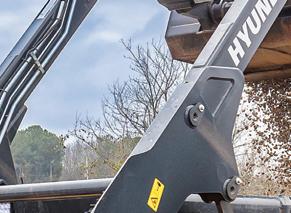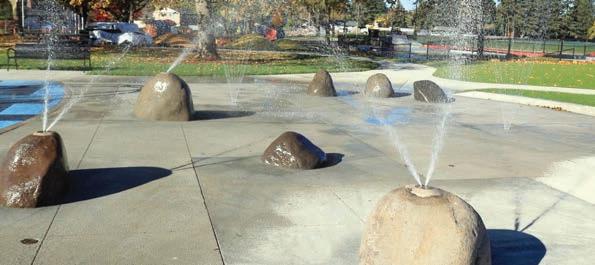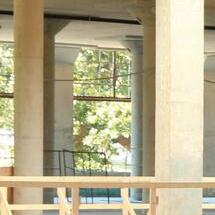

“The Nation’s



“The Nation’s
By Lori Lovely CEG CORRESPONDENT
The Idaho Transportation Department (ITD) is reconstructing the interchange at Interstate 90 and State Highway 41 in Post Falls, as well as improving SH 41 and local roads surrounding the interchange.
The project was awarded to Scarsella Brothers Inc. of Seattle, Wash., for $78 million.
The current interchange was constructed in the early 1970s, with modifications to the eastbound off-ramp in the early 1990s.
“The irregular intersection of Seltice Way and ID 41 has served its design life and is now a challenge for motorists,” said Heather McDaniel, public information officer of the Idaho Transportation Department, District 1. With average daily traffic numbers for 2025 around 66,250, she added, “Congestion in recent years has contributed to multiple severe and fatal crashes, especially at the westbound off-ramp.”
The plan to replace and upgrade the interchange at I90 and SH 41 emerged as part of the I-90 Corridor Study from the Washington state line to 15th Street in Coeur d’Alene, Idaho, McDaniel said.
The interchange is a central point of connection for other corridor projects planned to be built in future years, including expansion of the interstate to four lanes in each direction and the development of other improved interchange locations at U.S. 95 and Northwest Boulevard.
“Once finished, the reconstructed interchange will improve safety, increase capacity, provide better connectivity to SH-41 and position I-90 for future expansion,” said Shannon Stein, ITD project manager.
This complex interchange construction project includes building significant infrastructure such as:
• 1.3 mi. of I-90 pavement reconstruction;
• SH 41 widening and pavement reconstruction from Seltice Way to 12th Avenue;
• .5 mi. of widening and pavement reconstruction of Seltice Way;
• six permanent bridges;
• two temporary bridges;
• eight retaining walls;
• two pedestrian underpasses;
• one pedestrian bridge;
• upgrades to intersections with three traffic signals;
• one pedestrian (“hawk”) signal; and
see I-90 page 8


The interchange at Interstate 90 and State Highway 41 in Post Falls, Idaho, is undergoing multiple improvements.
























































The finish line for the State Route 167 Completion Project in Pierce County is getting closer with the selection of a contractor for the fourth and final stage of design and construction.
On May 22, 2025, the Washington State Department of Transportation (WSDOT) announced that Kraemer-Scarsella Joint Venture is the highest scoring proposer for a progressive design-build contract for the remaining 2.6 mi. of the SR 167 Expressway between Interstate 5 in Fife and State Route 161/North Meridian Avenue in Puyallup.
The selection of Kraemer-Scarsella Joint Venture means that all seven Puget Sound Gateway Program projects to finish SR 167 in Pierce County and SR 509 in south King County are either complete, under construction or final design and construction is imminent.
General contractors Kraemer North America and Kent-based Scarsella Bros. Inc. joined forces to submit a proposal for the last stage of the SR 167 Completion Project. WSDOT evaluated five different teams and invited two of them to submit proposals.
“The quality of both proposing teams was outstanding,” said Steve Fuchs, SR 167 project manager. “In the end, Kraemer-Scarsella Joint Venture stood out for its extensive experience successfully delivering progressive design-build projects, including its current project building Confluence Parkway in Wenatchee.”
The contract is worth up to $475 million.
WSDOT is using a contracting method called progressive design-build on a major highway construction project for the first
time. It is the same contracting method being used to correct 58 fish barrier locations in western Washington.
Progressive design-build divides the contract into two phases.
During the first phase, Kraemer-Scarsella Joint Venture will collaboratively review and confirm the initial designs with WSDOT. WSDOT and the contracting team will identify and mitigate project risks and incorporate design and construction innovations.
A final construction cost for the project will be developed and agreed upon. The second phase of the contract includes completing the final design and construction.
“This progressive design-build contract
provides us with multiple advantages in our current economic climate,” said John White, Puget Sound Gateway program administrator. “It allows us to work collaboratively with the contractor to make sure that we all agree in advance on construction strategies, innovations, risks and together we develop the costs associated with those elements.”
Design work will continue for approximately a year with construction slated to begin in mid-2026.
In addition to completing the four-lane expressway, the project includes:
• multimodal elements, including connections to regional trails;



• local road and intersection improvements;
• eight new bridges; and
• restoration of approximately 90 acres of stream and wetland habitat.
The SR 167 Completion Project builds 6 mi. of new tolled highway between Puyallup and the Port of Tacoma.
The first stage of work completed the new Wapato Way East bridge and State Route 99 roundabout in Fife. The second stage builds the expressway between I-5 and the Port of Tacoma. It’s scheduled to open in 2026. Work on the third stage between SR 161/North Meridian Avenue and State Route 410 began in 2025.
The entire project is planned for completion by 2030.
(All photos courtesy of Washington State Department of Transportation.)
















Loved for the features. Trusted for the performance.














Do more without feeling like it in Hyundai’s easy to own, easy to operate, skid steer and compact track loader.
Standard features include:
• LED front and rear work lights
• Auto leveling bucket
• Ride control
• Review camera
• Two speed travel
• AM/FM bluetooth radio
• Free Hi MATE telematics access for 5 years

wonder so many first-time Hyundai users become longtime fans. See the Hyundai difference yourself at your local dealer, or na.hd-hyundaice.com









Idaho Cleanup Project (ICP) crews completed the demolition of the Submarine 1st Generation Westinghouse (S1W) naval reactor prototype plant on May 31, 2025, safely using explosives to carry out this key milestone, according to the U.S. Department of Energy (DOE)
The effort, overseen by the DOE Office of Environmental Management (EM) and ICP contractor Idaho Environmental Coalition (IEC), marks significant progress in reducing the legacy footprint at the Naval Reactors Facility (NRF) at the Idaho National Laboratory Site in Idaho Falls, Idaho.
The carefully planned demolition followed extensive efforts that began in 2022 to safely remove contaminated and hazardous materials from the historic building. Earlier this year, ICP crews also removed the S1W’s defueled reactor vessel, disposing of it in a nearby onsite disposal facility in accordance with federal and state regulations.
The S1W demolition project has maintained an accelerated pace, completing work three months ahead of schedule and about $16 million under budget.
Mike Swartz, IEC’s senior manager over demolition projects, commended the effort of the employees who worked hard on this significant accomplishment.
“This milestone represents the professionalism and dedication from every member of our team,” said Swartz. “Their ability to safely and efficiently execute complex work like this demolition will allow us to successfully complete our mission at NRF.”
While EM and IEC are responsible for managing the demolition of the S1W and

other historic reactor vessel prototypes at NRF, acting ICP Manager Nick Balsmeier recognizes the importance of an effective partnership with the U.S. Naval Nuclear Propulsion Program.
“I am incredibly proud of IEC and their team, and grateful for support from our partners at Naval Reactors,” said Balsmeier. “It is the collective effort that will allow DOE to continue meeting our cleanup commitments and enable a strong future at the Idaho National Laboratory Site.”
In the coming months, crews will remove the remaining debris from the S1W plant demolition project, recycling material to the extent practicable. Crews anticipate completing the remaining work associated with the demolition project this fall.
The S1W is a defueled naval nuclear propulsion plant prototype and supported the development of the USS Nautilus, which was launched in 1955 as the world's first operational nuclear-powered submarine. S1W was built to simulate a submarine hull,
with a nuclear reactor compartment surrounded by more than 300,000 gal. of water to mimic ocean-like conditions.
David Honabach, a former student and staff instructor at the S1W, reflected on the significant role the S1W and NRF played in proving a new technology that propelled the development of the U.S. nuclear navy fleet.
“When you go all the way back…you can look at the challenges that we had. And you could look at where we were as a nation and what we were trying to solve. For S1W…we were really trying to convince the military and the nation, as nuclear power technology was becoming available, how to convert from diesel to nuclear power, proving that that was capable, proving that it could fit into a submarine hull,” said Honabach.
In addition to providing critical research and development, S1W served as a training ground for thousands of prospective students. Honabach provided insight into training and how the S1W developed a skilled, competent force of nuclear submarine operators.
“From the Navy side, it was really about the training of students. We recognized that there was a significant number of students that went before us. And we recognized the importance of being trained and qualified on a land-based prototype before we actually went, in our case, to a submarine,” he said. “We understood that that was absolutely critical in order to obtain our submarine warfare qualifications and to be able to be a productive crew member once you got to your first submarine.”
(Photo courtesy of the U.S. Department of Energy.)
Construction has begun on a $203 million project to improve Interstate 5 in Snohomish County, Washington, according to herald.net.
From June 20-23, the Washington State Department of Transportation (WSDOT) closed two northbound lanes of I-5 on the Ship Canal Bridge in Seattle. And northbound I-5 will be closed entirely between July 18-21 in much of Seattle in advance of a two-lane reduction between July 21 and Aug. 15. Northbound I-5 will fully close again from Aug. 15-18 before reopening, according to herald.net.
Guy F. Atkinson Construction is the project’s contractor, according

to WSDOT.
During this summer’s closures, contractor crews will:
• repair and resurface about 20 percent of the northbound Ship Canal Bridge;
• partially repair five expansion joints; and
• replace bridge drain inlets.
More construction is set to take place through 2027 to complete more repairs and repave the surface of the bridge.
The bridge carries about 200,000 vehicles daily.
When planning the repair project, WSDOT considered limiting the closures to nights and weekends, but that would have extended the timeline of the repairs significantly, Pearce told herald.net.
“This thing would have taken a minimum of 10 years to finish,” he said.
Additional closures are planned in both 2026 and 2027. Construction work will briefly pause during the FIFA World Cup in the summer of 2026, according to herald.net.
“It’s work that needs to be done,” Tom Pearce, communications consultant of WSDOT, told mynorth-west.com. “The Ship Canal Bridge is 60 years old. We’ve been out to do repairs more than 200 times in the last five years on the bridge, both northbound and southbound, and we need to get in there and do more work so that we can preserve the bridge.”






















































The $29.7 million expansion of Parklane Park in southeast Portland, Ore., debuted in time for the summer with features including a splash pad, basketball and tennis courts, a skatepark and a playground, according to oregonlive.com.
The overhaul, which expanded the park from five to 25 acres, was designed by landscape architecture firm Walker Macy and constructed by Stacy Witbeck. The project took more than five years to complete, including design and construction.
“The expanded Parklane Park is a community centerpiece,” said Adena Long, Portland Parks & Recreation director in a news release. “It helps address the significant lack of parks, open spaces and recreation in the Centennial neighborhood.”
The overhaul wasn’t paid for with tax money, the parks bureau said, according to oregonlive.com
The bureau said it used money
raised through system development charges or fees that developers pay when building new real estate developments. Former commissioners Amanda Fritz and, later, Carmen Rubio approved the funds during their tenures overseeing the parks bureau.
Parklane Park is now Portland’s largest developed park east of Interstate 20 and serves more than 2,800 nearby homes, according to the bureau, oregonlive.com reported.
Although the park opened to the
public in May, an opening day celebration was held on June 12. Challenges developed during the project, particularly because a former rock quarry was part of the newly developed 20 acres, according to portland.gov. Because that area was filled in with multiple kinds of materials, the soil stability varied, as did drainage.
Contractors planted 47 test trees from 19 species that will be monitored for 18 months to see which species survive best. Any trees that fail will be replaced and 175 more


trees will be planted in spring 2027. Other changes included reducing the developed area by five acres to create a larger buffer and moving features like sports courts and the skate park outside of the former quarry fill area. Cost inflation spurred by the pandemic was cited as another challenge. (All photos courtesy of portland.gov.)
• utilities, drainage and signage improvements throughout the project limits
The ITD approved a bond sale in February 2022 to advance the project, enabling it to start construction one year early.
Funding for some elements of the project comes from Gov. Brad Little’s “Leading Idaho” Initiative, which includes the “Transportation Expansion and Congestion Mitigation, or TECM, program. It is the largest transportation funding package in Idaho’s history.
The program allows ITD to accelerate project timelines to address rapid growth and build critical infrastructure today that would otherwise take many years to fund and build. Because of the program, construction of the I-90, SH 14 interchange was advanced a full year earlier than expected.
According to Randy Durland, ITD’s project manager, liquidated damages for not completing within 540 working days will be assessed at $12,000 per day. Conversely, there is a $300,000 incentive if both the following conditions are met:
• Complete Seltice Way construction so that lane reductions are in place less than a total of 200 calendar days.
• Sequence the work so that two through-lanes in each direction are open to traffic during peak travel hours on Seltice Way throughout the Ramp CD (westbound off) closure.
Progress
Construction will be under way through the summer of 2025. Work this year will include:
• building the new westbound off-ramp;
• building the new SPUI operation;
• widening SH-41 to Mullan Avenue; and
• finishing the SH 41/Mullan Avenue intersection.
The project will take four seasons to complete because ITD believes it’s important to keep this interchange open to traffic during construction. If the interchange could be completely closed, construction could be completed more quickly.
This season will focus on constructing the concrete pavement of the SPUI as well as the signal structure for it, Durland said. To complete this work, crews are using a Guntert & Zimmerman S605 Slipform Concrete paver.
Interstate Concrete and Asphalt in Rathdrum, Idaho, is pouring the Hot Mix Asphalt (HMA) and concrete pavement surfaces. Any milled HMA removed from the existing pavement is being reused in a portion of the new pavement.
Scarsella averages 15 to 25 crew members onsite daily, working 7 a.m. to 5 p.m. Monday through Friday. Night work will be scheduled from 8 p.m. to 5 a.m. During special events, night work will begin at 10 p.m.
Based on the analysis, noise walls were not warranted; however, a study is underway to look at the expansion of I90 and determine if they are warranted in the corridor.
The design team consulted with community partners such as emergency services and law enforcement to mitigate safety concerns with the construction of pedestrian underpasses. These underpasses will be well-lit and short enough to see through to maximize visibility and safety.
Both underpasses will be 14 ft. wide and 10 ft. tall, mak-
ing them larger than the underpass to access Silverwood off U.S. 95. The inside of the underpass under the I-90 westbound on-ramp will be visible from Seltice Way, and the underpass under SH41 will be visible from Primrose Lane, which will improve safety and ease of patrolling.
“Congested, staged construction has been the most challenging aspect of the project,” Durland said.
Scarsella mitigated this challenge with scheduled night shift operations to complete complicated staged construction that would not be possible during the day with the amount of traffic within the project limits.
The speed limit was lowered to 55 mph on I-90 and 25 mph on SH 41 and Seltice Way. There are lane restrictions on SH 41, along with intermittent lane restrictions on I-90 at night.
The weather has played a major challenge when scheduling traffic switches on I-90. Cooler temperatures at night and abnormal popup storms have impacted many scheduled traffic switches that require careful planning with subcontractors to complete the work alongside Scarsella. Durland said that Scarsella and the subcontractors stayed focused on the goal and grouped other work that is not weather-dependent.
“ITD and Scarsella have been working closely together to deliver and complete this major intersection upgrade for local traffic,” Durland said. Challenges with time constraints, traffic and staging have been a common topic of conversation.
Over the next four seasons, work will shift from I-90 to SH 41 and then to Seltice Way.
Project completion is expected in 2026. CEG (All photos courtesy of Idaho Transportation Commission.)













The federal Department of Energy is about to start a three-year construction project vital to the environmental cleanup of the Hanford nuclear site in Eastern Washington, Tri-City Herald reported.
The lined landfill at the 580-sq.-mi. nuclear reservation is again nearing capacity after four expansions and more than 19 million tons of waste disposed of in it since its 1995 opening.
Subcontractors for the new super cell’s
excavation are AIS Infrastructure, Envirotech and Weaver Consultants Group, Tri-City Herald reported.
Workers are about to start building an 11th disposal cell. It is being called a “super cell” because it is twice the size of each of the Environmental Restoration Disposal Facility’s first eight cells.



















The project will cost $95 million. Completion is expected by the end of September 2028, according to Tri-City Herald.
“ERDF has been a cornerstone of our waste disposal strategy for nearly 30 years, and expansion of the facility is critical to provide for uninterrupted, efficient and safe disposal in support of our ongoing cleanup mission for years to come,” said Brian Harkins, acting manager of DOE at Hanford.
The new cell will hold 2.8 million cu. yds. of waste. That’s enough space to allow certain environmental cleanup projects to continue through 2040.
The landfill is used to dispose of low-level radioactive and hazardous chemical waste. That includes the debris from the demolition of more than 800 facilities and also from digging up contaminated soil and debris from 1,300 waste sites, Tri-City Herald reported.
Approximately 10,000 tons to 15,000 tons are disposed of in the landfill each month, but when the cleanup was focused on work along the Columbia River, that amount could be disposed of in a day.
The Hanford site adjacent to Richland was originally contaminated by the production of nearly two-thirds of the plutonium for the nation’s nuclear weapons program from World War II through the Cold War, Tri-City Herald reported.













A separate lined landfill, the Integrated Disposal Facility, was built elsewhere in central Hanford for glassified low-activity waste retrieved from Hanford’s underground waste storage tanks, then treated at the Hanford vitrification plant for disposal.
Other waste will be sent offsite for disposal, including grouted low-activity tank waste, glassified high-level waste and transuranic waste. At Hanford, that is typically debris contaminated with plutonium.
The new super cell’s construction won’t impact ongoing waste disposal activities at ERDF.
The 107-acre landfill features a liner system that collects rain, snow melt and the water used to suppress dust. That prevents contamination from being carried by water from the landfill through the soil to the groundwater far below ERDF, according to Tri-City Herald.
A secondary liner system provides for the early detection of leaks from the primary liner. Both will be in use until the landfill closes.
After the landfill is no longer used for environmental cleanup, a barrier will cover it and desert plants will grow on it, soaking up the precipitation that falls in a normal year at Hanford, according to Tri-City Herald.




